“Obsession” Would Be a Fitting Theme in Arkham City’s Narrative
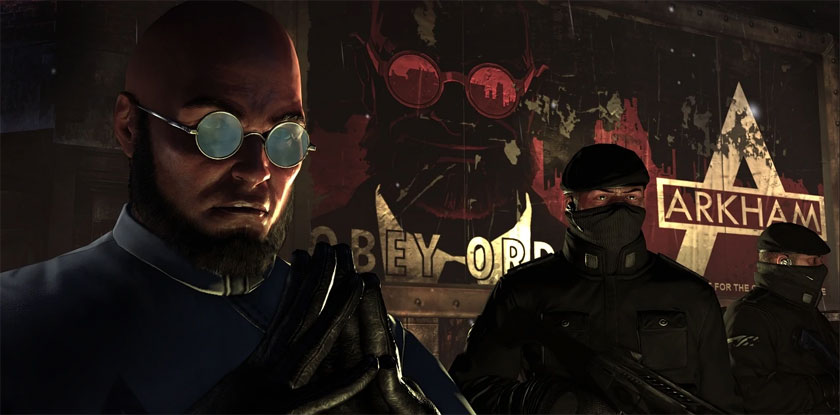
In my previous essay on Arkham City, I noted how “distraction” was as much a theme of the gameplay as it seemed to be in the narrative. Batman’s attention seems to be pulled anywhere but the primary threat throughout the length of the game. Be it Catwoman strung up by Two-Face in the courthouse, Joker injecting his infected blood into Batman’s veins, Penguin imprisoning Mr. Freeze and torturing a group of previously undercover cops, or the various scattered diversions throughout the city, Batman just cannot seem to sit down and focus on the matter at hand.
I feel as if this is the result of two conflicting desires. The first is to tell yet another story centered on the Joker and his relationship to Batman. The second uses Hugo Strange to justify the existence of the rather implausible and titular Arkham City. While similar open-world superhero games like Marvel’s Spider-Man or the inFamous franchise are more than happy to include civilians in their city settings, Rocksteady and Warner Bros. Montreal seemed insistent on creating a game world where only thugs, criminals, and the occasional political prisoner exist. This is why future spin-off entry Arkham Origins takes place during a snowstorm where all the innocent, law-abiding citizens remain sheltered in their homes, or Arkham Knight’s Gotham takes place after the civilians have evacuated the city. It wouldn’t make sense to have civilians wandering the streets when so many armed criminals are on the loose. Why are so many armed criminals on the loose? For the sake of the gameplay desires and ambitions of the developers.
As such, Hugo Strange is used to contextualize Arkham City. As outlandish and “comic book” as the concept is, it works for the sake of the gameplay. However, once the context of the setting has been addressed, the game developers seem to just shrug it off in pursuit of the Joker storyline. Or, perhaps, the story itself only exists in order to string together set pieces. Someone had a cool idea for a fight against Mr. Freeze, but there needs to be a reason for that fight to exist. Ah! How about Penguin’s has trapped Mr. Freeze in the Iceberg Lounge, and in order to fight Mr. Freeze you must first defeat the Penguin? Oh, and we can throw in that shark idea while we’re at it! Wait, why is Batman rescuing Mr. Freeze?
This seems like the simplest explanation for Arkham City’s scatter-brained story. A series of set-pieces created first, stitched together by a desperate attempt to contextualize the whole lot of nonsense during the late stages of development. Unfortunately, there’s a key moment towards the game’s end that leads me to believe the writers – which included Paul Dini, one of the lead writers of the 90’s era animated series – had something a little more substantial in mind.
Note that the rest of this post will be heavy on spoilers.
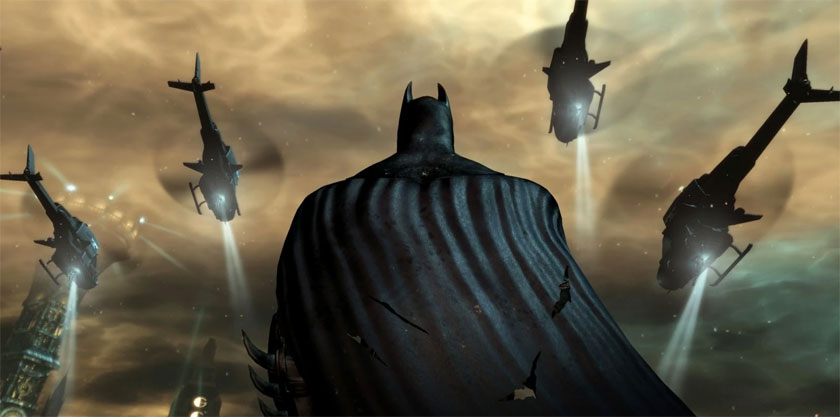
The final act of the game begins with Hugo Strange unleashing Protocol 10 upon prison city. The entire concept of a walled off urban prison was a charade for this moment, manipulating the city’s politicians into allowing Strange to use his Tyger force guards to mow down and blow up Gotham’s population of criminals, both minor and super. Despite this destruction, Batman is intent on chasing down the Joker, who had just escaped with part-time paramor Talia al Ghul and, presumably, the cure to the Joker toxin. It is only after Oracle – Barbara Gordon’s alter-ego after having been paralyzed and bound to a wheelchair by Joker – and Alfred give the Dark Knight a stern talking to that our hero acquiesces. Maybe, just maybe, the scale of destruction being unleashed by Hugo Strange at this very moment is a more pressing need of his attention.
Several years ago, after I had completed Arkham Knight, I suggested to my friends that maybe, just maybe, Kevin Conroy wasn’t up to the task of portraying that particular type of Batman. It would almost be hyperbole to suggest that their faces reddened and teeth grit with a deep and boiling rage at such blasphemy spoken aloud. After all, Kevin Conroy is Batman, just as much as Mark Hamill is the Joker (or was the only Joker, until Heath Ledger gave an undeniably excellent performance as the character in The Dark Knight). If we’re talking about calm, empathetic, but most-of-all professional Batman, then I agree. Kevin Conroy is the voice I hear in my head every time I read The Long Halloween, Dark Victory, Batman: Year One, or Hush. Kevin Conroy’s voice has defined the character for me throughout my life.
Unfortunately, he’s not so convincing at angry, threatening, questionable-interrogation-methods Batman. His attempts to shout with an unbridled rage instead bring to mind the kindest neighborhood father whose heart just isn’t into scolding his puppy for tracking mud prints through the house. He’s trying, God bless him he’s trying, but I can’t help but imagine Kevin in the soundbooth looking at the director with concern, asking if he’s sure this won’t scare the children.
The point of my two paragraph digression is that, for me, Kevin Conroy failed to deliver the drama demanded by the writing in Batman: Arkham Knight. That’s fine! He’s just not that kind of Batman. Here in Arkham City, however, I believe it is the writing that fails the character, not Kevin Conroy. Perhaps it’s partially because Paul Dini is on the writing staff, but Batman’s dialogue throughout the game carries the same calm, collected, professional tone that I’ve always come to expect from the character. While the player themselves may question whether Batman ought to spend a bit more time digging into Protocol 10, Robin, Oracle, and Alfred never really seem to insist at any point that Protocol 10 should take precedence. In fact, Oracle and Robin are given dialogue that raises the stakes of the toxin’s impact, and therefore emphasizing its importance as a threat to the player. Should Batman fail to get the cure distributed by morning, thousands of innocents could die. Those are some pretty big stakes, especially compared to the… nothing the player knows about Protocol 10.
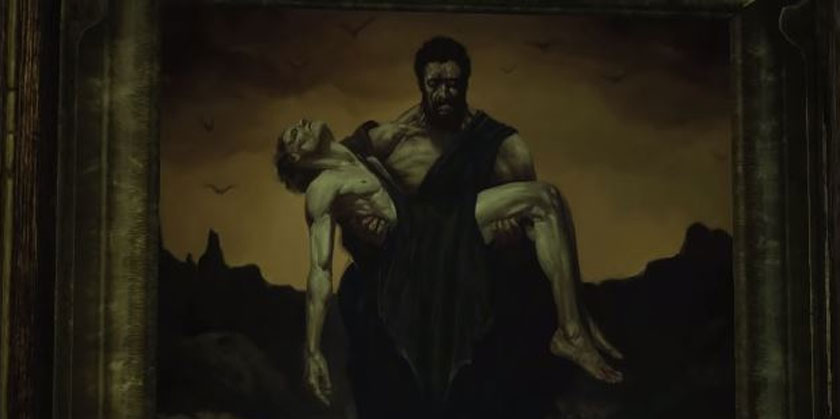
When Batman decides it’s time to chase down the Joker despite the immediate carnage and destruction surrounding him, it’s the first time in the game the player is made aware that his judgment is, perhaps, being compromised. Once Hugo Strange has been taken care of and Batman has retrieved the cure from the Joker, he stands there, recounting all the pain, death, and torment caused by the Clown Prince. It is the first time in the course of two games Batman has shown even a hint of temptation to kill or allow the Joker to die. Watching Batman carry Joker out of Arkham City, the police looking onward in shock and silence, it all felt… wrong. Never was there an indication that Batman felt any sort of emotional connection, aggressive or not, to the Joker throughout the whole game. If anything, we get more emotional connection between Batman and Mr. Freeze, Catwoman, Talia and Ra’s al Ghul. There’s a grudging respect for Freeze despite the clear disapproval of the man’s methods. He knows there’s a good heart in Catwoman. When Talia sees how pale Joker’s toxin has made him, Batman swiftly and sheepishly covers his face back up with the cowl. While none of these characters get much, they all get some form of dialogue that reflects on Batman’s relationship with them. With Joker, it’s the same series of empty threats, such as declaring he’ll die right alongside Joker once infected with the tainted blood.
When Arkham City released, the ending was received quite highly throughout the gaming press and community. You can still find articles and YouTube videos celebrating its conclusion as if it were perfect, particularly as a send-off to Mark Hamill’s Joker. Everyone thought he was retiring from the role at the time, and therefore this ending seemed like the perfect gut-punching farewell to one of the most iconic performers of the character. It is for this reason that I believe all the emotional weight is found not in the writing, but in the head canon and willful buy-in by the fans.
In regards to “buy-in”, I refer to such imagery as the “foreshadowing” of its ending with an opening shot of a painting depicting Cain and Abel – a painting that makes absolutely no sense to the Biblical context of the brother’s relationship and that of Batman and Joker’s. This image certainly seems meaningful, but only because that’s the sort of thing a film director might place in their film. The same can be said for the first shot we see of the Batsuit, which Shamus Young cleverly pointed out is designed to resemble a huge grin. If I were to hazard a guess, this shot is intended to either foreshadow or reflect the toxic Joker blood that will be coursing through Batman’s veins throughout the course of the game. The notion of there being a “little bit of Joker” in Batman beyond that, as if Batman is just as insane as everyone else, is not supported by the text. Not beyond an accusation of the Joker’s, at least, and he makes such claims all the time.
I fully believe there was a greater intent for the writers to inject thematic depth into Arkham City, but it got too caught up in its individual supervillain pummeling episodes to tie it all together through its one constant: Batman himself. Mr. Freeze, for example, is characterized by his obsession to discover a cure for his cryogenically frozen wife Nora. His desire to cure her runs so deep that he is willing to break the law to get what he wants. This is part of his character, and it’s what makes him a suitable villain to include in Arkham City’s narrative. He demonstrates how such an obsession can compromise someone’s moral compass and otherwise rational mindset.
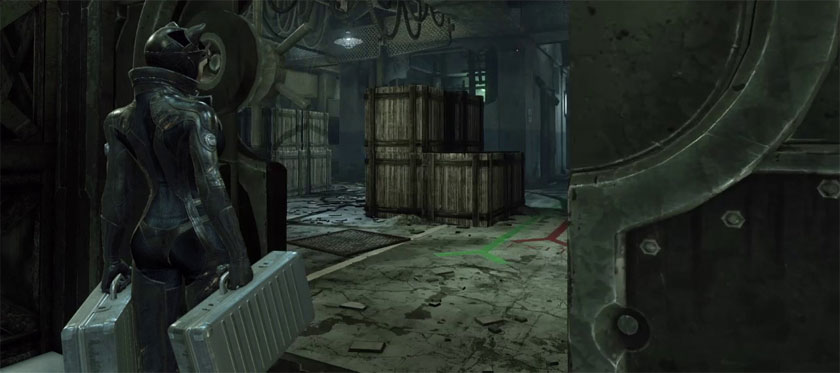
A neat little touch I like in this scene is, as you leave the vault, the floor has two obvious lines painted on the floor. The green leads to the canonical choice of saving Batman. The red leads to the “bad” ending.
Catwoman is similarly obsessed with treasure. A thief with a heart of gold, she spends her own side-story chasing down a score with which she hopes to flee Gotham and live easy. Unlike Mr. Freeze, who only helps Batman after feasting upon a banquet of knuckle sandwiches, Catwoman gives up her hardwon cash when Gotham’s caped crusader is in desperate need of a savior of his own. Though she is a criminal, she has enough of a conscience to recognize that helping the Dark Knight is the right thing to do.
Our primary yet forgotten antagonist Hugo Strange is, himself, obsessed with the Batman. More specifically, he desperately yearns to prove his superiority. The obsession runs so deep that he wants Batman to not only fail, but to know precisely who defeated him. It is for this reason Strange tells Batman so much of his plan at the game’s beginning. All but the specifics of Protocol 10.
One of the game’s twists is that Hugo has been working with Ra’s al Ghul the whole time. Perhaps this is conjecture, but I feel Hugo Strange is not so much interested in leading the League of Assassins so much as accomplishing that which Batman “never could”. He doesn’t share in the dream of Ra’s al Ghul so much as covet the throne previously reserved for Batman. To possess that which Batman could not would prove to be the ultimate victory, even if, in truth, it is a prize that Batman would not accept.
Similarly, Ra’s al Ghul is a villain twice obsessed; he desperately yearns to see his vision of the future fulfilled, but he can only do that with a worthy successor. Batman is the only man that has proven worthy of such a title, and therefore repeatedly fights and struggles to win the Dark Knight to his side. All of this is represented in the game and makes for a far better cyclical relationship of mutual respect yet antagonism than anything we see between Batman and the Joker.
Minor villains are even included in this pattern of characterization. Victor Zsasz is driven by an impulsive need to not only kill, but to cut a mark in his own flesh for each of his victims. The Mad Hatter is driven by a delusional obsession with finding his “Alice”, a name given to the women he kidnaps, imprisons, and inevitably kills. The Riddler’s obsession with outsmarting Batman is also ever present, though perhaps redundant and more obvious compared to Hugo’s quite similar motivation.
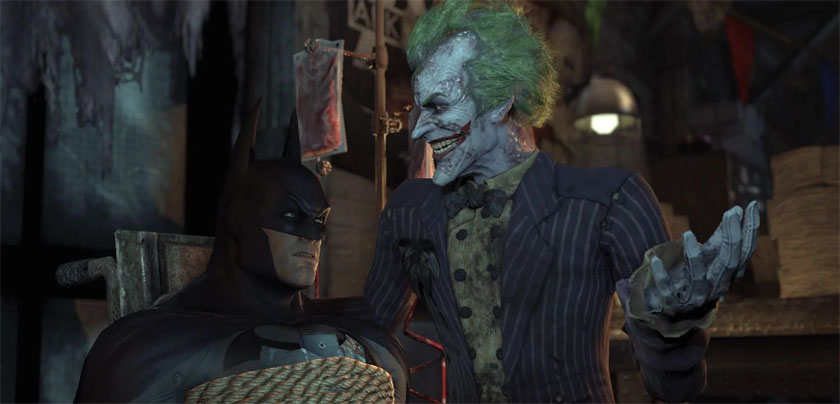
“Stop me if you heard this one.”
The one area where this concept of obsession is conspicuously absent – and yet where it would be the most necessary for the concluding story beats to work – is between Batman and the Joker. Every action of Joker’s makes sense in that perfectly twisted Joker way. He recruits Clayface to act as a double to him while manipulating and relying on Batman in order to create a cure. Injecting his blood into Batman is the first step into ensuring the vigilante will comply. In the predictable event that Batman refuses, inform him of all the innocents that have also been infected. Once provoked into action and the cure has been created, steal it. After all, only super heroes fight fair.
That Joker would rely on Batman specifically is perfectly in-character and has nothing to do with some twisted co-dependent relationship. He’s the only capable individual selfless enough to be manipulated into not only finding a cure, but being willing to save the Joker. None of the other supervillains would shed a tear if Joker were to die, and would likely use Joker’s own desperation for their own profit before letting him croak. Given his moral compass and physical and mental prowess, Batman is the Joker’s best bet. Similarly, pursuing a cure is a necessity if Batman wishes to not only survive, but to stop Hugo Strange and save all of the infected patients in Gotham’s hospitals.
Each character’s motivation makes sense. The only hint of obsession between the two is a series of voicemails from the Joker. Of course, he keeps calling Batman because he’s dying, and therefore would be particularly interested in the progress Batman is making. If Joker is obsessed with anything, he’s obsessed with staying alive.
Which is why the closing hours of this game are so emotionally ineffective for me. Never does Batman himself seem to wonder if he should just let Joker die. Not outside of his tough guy “then we both die!” declaration, a threat swiftly dismissed by the Joker. None of his allies ever seem to question whether Batman should just let the Joker die. Mr. Freeze never asks Batman why he’d let a mad man such as the Joker live. Catwoman doesn’t reprimand Batman for considering Joker before Protocol 10, particularly in light of the fortune she willingly let go. There is neither an obsession to prioritize Joker above all else within Batman nor a temptation to just let the villain die until the cure is within his hands.
Batman remains a calm and stoic professional except for when he’s around Talia al Ghul or when Hugo Strange is lying on the ground, pierced through by Ra’s al Ghul’s blade. Those are the only other two times his demeanor breaks. To ensure that players understand why Batman drops the hardened hero act with Talia, Oracle first contextualizes and lectures our protagonist regarding his history with her. That way, even players unfamiliar with the character understand the nature of their relationship. When Batman wishes to save Hugo, it’s because we have firmly established through his interactions with Ra’s that he will not kill. The only new knowledge within that scene is that Batman simultaneously will try to prevent anyone dying if he can help it.
In each scenario, the player is provided enough information from the game’s text to understand why Batman reacts the way he does.
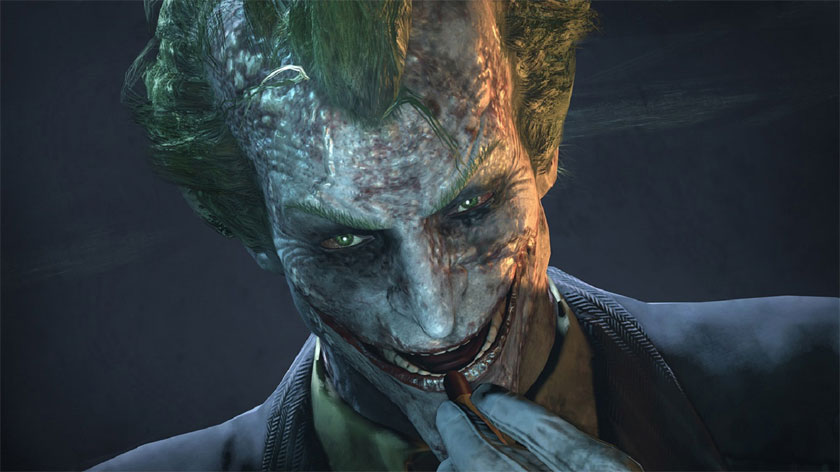
It’s why it feels so sudden and out of left-field that Batman stands there, holding that antidote vial, seeming to question whether it’s worth saving Joker’s life. Or, perhaps, he wasn’t questioning at all. He was only trying to illustrate to Joker all the reasons he should die, but would allow him to live anyway. Unfortunately, the manner in which the scene plays out, the player can never know. Just that Batman would have given Joker the cure anyway.
Perhaps other fans of the Batman mythos were pleased with this scene because of the excellent direction, voice acting, and overall production. It at least feels somewhat impactful, so long as you’re willing to just follow along with the mood they’re conveying. For my part, however, I feel as if this relationship dynamic has been portrayed far better in works like The Killing Joke or The Dark Knight.
This, too, is a reason I think I never quite latched on to Arkham City as much as I had Arkham Asylum. The first game felt like a perfectly told Batman story without any pretentious posturing. Joker was the mastermind and, as a result, had his fingerprints all over the narrative without being overshadowed by any of his fellow super criminals. Multiple villains managed to make an appearance, but never did any of them steal the show away from the Joker permanently.
At the same time, the narrative felt neither distracted nor rushed, whereas Arkham City feels compromised due to the greater scale of its open-world. I would not be surprised if a run through both games’ narratives – ignoring all side content and collectibles – would result in the second campaign’s total runtime coming up short.
Nevertheless, it still feels good to go in and pummel some thugs throughout the city. Despite feeling like the lesser of the two, I can’t deny that it’s at least a pretty sweet place to just glide in and deliver a kick to criminal skulls.


